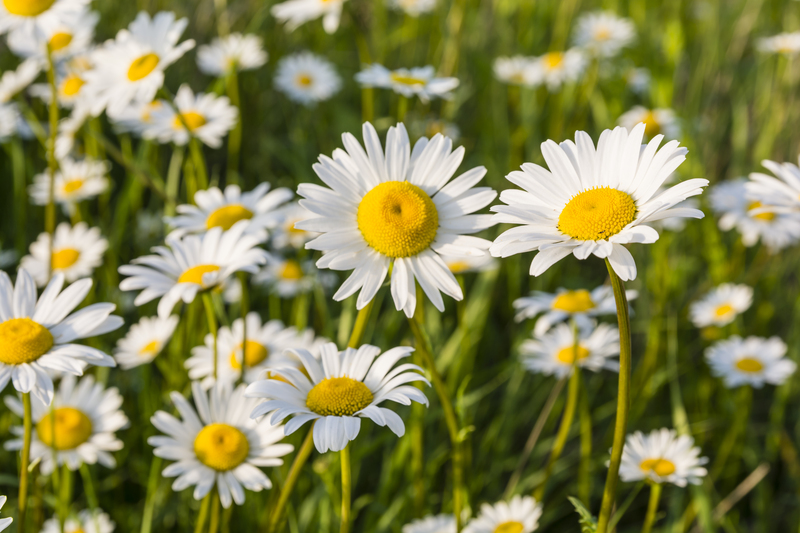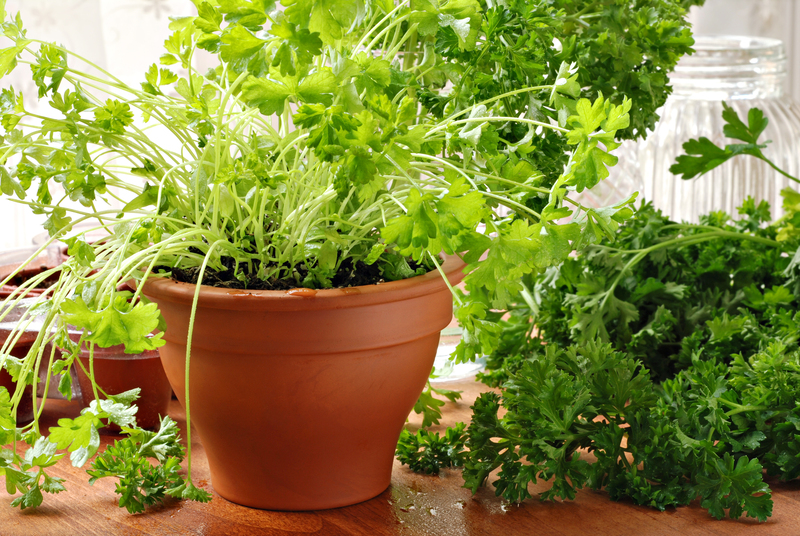Explore the Pleasures of Nurturing a Herb Garden
Posted on 09/06/2025
Explore the Pleasures of Nurturing a Herb Garden
Do you dream of plucking fresh basil for your pasta or soothing mint for your tea right from your own balcony or backyard? Imagine stepping outside into a vibrant oasis filled with the intoxicating aromas of rosemary, thyme, and lavender. This dream can be yours, as you explore the pleasures of nurturing a herb garden.
Why Start a Herb Garden?
Growing your own herbs is not just a hobby; it's a gateway to a healthier, more flavorful, and rewarding lifestyle. There's a sense of accomplishment and serenity when you care for plants and watch them flourish. Below, we uncover the many reasons why nurturing a home herb garden is both enjoyable and beneficial.
- Fresh Flavors Year-Round: Home-grown herbs infuse dishes with richer, fresher flavors than store-bought alternatives.
- Eco-Friendly: Reducing the need for packaged herbs minimizes your carbon footprint and plastic waste.
- Cost-Effective: Herbs are easy to propagate and multiply, saving you money in the long run.
- Health & Wellness: Many herbs have medicinal properties--growing them gives you easy access to natural remedies.
- Stress Relief & Mindfulness: Tending to your herb garden is a therapeutic, meditative activity that helps reduce stress.

Choosing the Right Place for Your Herb Garden
Selecting the ideal spot for your home herb garden is crucial. Most herbs thrive with at least six hours of direct sunlight, so aim for a south-facing window, balcony, or a sunny patch in your yard. For urban dwellers, windowsills and small planters work wonders.
Indoors vs. Outdoors: Pros and Cons
- Indoors: Easier to regulate temperature; herbs are within arm's reach while cooking, but may require supplemental lighting and careful watering.
- Outdoors: Offers more space and natural light, but may expose herbs to pests and harsh weather.
Tip: Consider starting small with container gardening if you have limited space, making it easier to manage and relocate your herbs as needed.
Essential Tools and Materials for Herb Gardening
Setting up a successful herb garden doesn't require a fortune. Here's an essential toolkit to get you started as you explore the joys of cultivating herbs at home:
- Quality Potting Soil: Choose well-draining, organic soil to support healthy herb growth.
- Planters or Pots: Ensure containers have adequate drainage holes to prevent root rot.
- Hand Trowel: Perfect for planting and transplanting herbs.
- Watering Can or Spray Bottle: Keeps herbs hydrated without overwatering.
- Plant Labels: Keep track of each herb variety, especially for beginners.
Optional: Grow lights for indoors, organic fertilizer, and organic pest repellents for ongoing care.
Selecting the Best Herbs for Your Garden
One of the true pleasures of maintaining an herb garden is choosing which herbs to grow. Favor those you use most in your cooking, or those with desirable scents and medicinal qualities.
Top Herbs for Beginners
- Basil: Sweet and fragrant, perfect for Italian and summer dishes.
- Mint: Vigorous and adaptable, great for tea and desserts.
- Parsley: Leaves add freshness and nutrients to salads and soups.
- Chives: Delicate onion flavor, superb in omelets and dips.
- Thyme: Woody, aromatic, ideal for slow-cooked recipes.
- Rosemary: Pine-scented, robust, excellent for roasts and breads.
- Cilantro: Essential for salsas, curries, and chutneys.
Advanced gardeners may explore lavender, sage, oregano, and tarragon for specialized culinary or wellness uses.
How to Plant Your Herb Garden
Proper planting is a key step towards enjoying the rewards of herb gardening. Here's a step-by-step guide to get your herbs off to a thriving start:
- Prepare the Soil: Loosen and moisten your chosen potting soil.
- Plant Seeds or Seedlings: Most beginners have greater success starting with small plants, but sowing seeds is also rewarding. Follow packet instructions for depth and spacing.
- Water Gently: Moisten the soil without soaking it; herbs dislike soggy roots.
- Place in Sunlight: Position your containers where they receive optimal light.
- Label Each Herb: This helps you track care requirements as your collection grows.
Remember: Each herb has unique preferences--some require more moisture or shade than others. Research individual needs to maximize yields and health.
Daily Care and Maintenance for a Thriving Herb Garden
Watering
The secret to successful herb gardening at home is balanced watering. Most herb plants like slightly dry soil between watering. Overwatering may cause root rot, especially for Mediterranean herbs like rosemary and thyme. Always check the soil with your finger first--if the top inch is dry, it's time to water.
Feeding
Feed your herbs with a mild, organic, balanced fertilizer once a month during the growing season. Avoid heavy fertilizers, which promote leaf growth at the expense of flavor.
Pruning
Regularly snipping sprigs or leaves encourages bushy, robust growth. For most herbs, frequent harvesting during the growing season prevents them from flowering and keeps them productive longer.
Pest and Disease Management
A vital part of maintaining an herb garden is vigilance against common pests such as aphids, spider mites, and whiteflies. Use natural remedies like neem oil or insecticidal soaps to manage infestations. Watch out for fungal diseases--ensuring good airflow and proper watering is your first line of defense.
Sunlight and Temperature
Herbs need plenty of sunlight. Rotate pots every week if the light is one-sided. Protect tender herbs from frost in winter by bringing pots indoors or using mulch outdoors.
The Magic of Harvesting: Savor the Fruits of Your Care
There can be few greater pleasures than stepping into your garden and plucking handfuls of fresh herbs that you've grown yourself. Harvest often to encourage new growth, preferably early in the morning when their essential oils are most concentrated.
- Basil: Pinch off just above a leaf pair to promote branching.
- Mint: Cut stems to just above a leaf node.
- Rosemary & Thyme: Snip a few stems at a time, avoiding removing more than one-third at once.
Dry or freeze herbs for long-term storage, or use them immediately for unbeatable flavor and aroma.
Creative Uses for Homegrown Herbs
Your efforts in nurturing a herb garden pay off in infinite culinary, medicinal, and decorative ways. Here are some ideas to inspire you:
- Culinary Delights: Fresh pestos, herbed butters, salad dressings, teas, soups, and infused oils.
- Natural Remedies: Chamomile for calming tea, mint for digestive relief, sage and thyme for sore throats.
- DIY Beauty Products: Lavender bath salts, rosemary hair rinse, and parsley facial masks.
- Home Decor: Herbal wreaths, potpourri, and dried bouquets bring color and fragrance indoors.
Sustainable and Organic Practices in Herb Gardening
Choose organic seeds and earth-friendly gardening practices whenever possible. Composting kitchen scraps and using organic mulch enriches your soil naturally, while companion planting can keep pests at bay without harmful chemicals.
Eco-Tips for Greener Herb Gardens
- Collect rainwater for watering your herbs.
- Make your own compost from garden clippings and vegetable scraps.
- Plant pollinator-friendly herbs like basil, chives, and thyme to attract bees and butterflies.
- Use recycled containers for creative, sustainable planters.
Overcoming Common Challenges in Herb Gardening
Every gardener faces a few hiccups along the way. Here's how to troubleshoot frequent issues:
- Leggy Growth: Not enough sunlight. Move pots to a brighter location or use grow lights.
- Wilting: May be due to over or under watering. Check soil moisture regularly.
- Pale Leaves: Indicate a nutrient deficiency. Feed with a balanced organic fertilizer.
- Pest Infestation: Use insecticidal soap or introduce beneficial insects like ladybugs.
Remember: The key is observation. React promptly to changes in plant health for thriving, resilient herbs.
Herb Garden Design: Let Creativity Blossom
Small Spaces, Big Rewards
Even a simple windowsill or balcony can become a bountiful herb garden at home. Hang pots vertically, use stacked planters, or repurpose kitchen items for rustic charm.
Theme Your Garden
- Culinary Herb Garden: Concentrate on parsley, basil, oregano, thyme, and chives.
- Mediterranean Corner: Rosemary, sage, oregano, and lavender evoke the scents of the Mediterranean sun.
- Tea Garden: Mint, lemon balm, chamomile, and bergamot for a constant supply of relaxing brews.

Teaching Children the Joy of an Herb Garden
Introducing children to herb gardening is a wonderful way to instill a love for nature, science, and healthy food. Their curiosity is piqued by fast-growing herbs like cress and basil, and tasting fresh leaves right from the pot can spark lifelong healthy habits.
Final Thoughts: Savor the Journey of Herb Gardening
Nurturing a herb garden is an invitation to slow down and connect with nature. From the first sprout to the last aromatic harvest, each moment brings its own reward. Whether you're a gourmet chef, a health enthusiast, or simply looking to brighten your living space, the pleasures of nurturing a thriving herb garden are accessible to all.
Start your own herb garden today--no expertise required, only curiosity and care. Your senses, palate, and well-being will thank you!

